You are using an out of date browser. It may not display this or other websites correctly.
You should upgrade or use an alternative browser.
You should upgrade or use an alternative browser.
A high and dry, wild and wet, majestic history medley – RTW 2018
- Thread starter JohnM
- Start date
-
- Tags
- round the world
- Status
- Not open for further replies.
Read our AFF credit card guides and start earning more points now.
AFF Supporters can remove this and all advertisements
JohnM
Enthusiast
- Joined
- Jun 7, 2006
- Posts
- 11,812
- Qantas
- LT Gold
They keep swarming in.

Stunning vistas.

Stunning vista enhanced
 . And then less so…
. And then less so…


And something for @RooFlyer…

As the sun was setting we burned off to the W edge of the salar towards our salt lodge accommodation. But not before stopping for some more photo fun.


Accommodation on the salar was basic but good hostel-type. The walls are largely made of salt blocks and the floor is salt crystals. A fun night. Note Andreas, the German travel writer transcribing his voice memos in the background of the bottom pic.

Loading the next day. Get the novel solar HWS.

And now to head further west into the mountains… Woo hoo!

Stunning vistas.

Stunning vista enhanced


And something for @RooFlyer…

As the sun was setting we burned off to the W edge of the salar towards our salt lodge accommodation. But not before stopping for some more photo fun.


Accommodation on the salar was basic but good hostel-type. The walls are largely made of salt blocks and the floor is salt crystals. A fun night. Note Andreas, the German travel writer transcribing his voice memos in the background of the bottom pic.

Loading the next day. Get the novel solar HWS.

And now to head further west into the mountains… Woo hoo!
JohnM
Enthusiast
- Joined
- Jun 7, 2006
- Posts
- 11,812
- Qantas
- LT Gold
The route.

Heading into the Andean high altiplano.


Railway to the coast in Chile.

Then onto a section of a truck route to the coast – and some grief for one truckie.
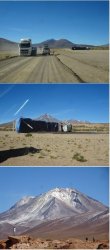
Magnificent solitude – although we’re not alone. This is a well-trodden route – but only by 4WD.

Moving on via a lake with plenty of flamingos for a lunch stop.


Leaving the flamingos and climbing. Getting a bit rougher. One regret is that I wasn’t driving – although I did plenty on the other side of the border in Chile a few years back (High, dry and breathless in the Atacama desert).

Howling wind and very cold – but sensational fun!


Heading into the Andean high altiplano.


Railway to the coast in Chile.

Then onto a section of a truck route to the coast – and some grief for one truckie.

Magnificent solitude – although we’re not alone. This is a well-trodden route – but only by 4WD.

Moving on via a lake with plenty of flamingos for a lunch stop.


Leaving the flamingos and climbing. Getting a bit rougher. One regret is that I wasn’t driving – although I did plenty on the other side of the border in Chile a few years back (High, dry and breathless in the Atacama desert).

Howling wind and very cold – but sensational fun!

JohnM
Enthusiast
- Joined
- Jun 7, 2006
- Posts
- 11,812
- Qantas
- LT Gold
Onwards past wind-blasted rock formations and ancient volcanoes to Laguna Colorado (red lake).

Accommodation in the National Park is basic but quite serviceable for an overnight stay, especially as we got in just on dark and were up early to be away by 0500h the next day. It’s really just a rather large refugio. Our meal was prepared by our drivers. This is expedition travel.
It was still dark when we got going next morning. The refugio was at a little over 4200m and we were heading to peak just on 5000m at Sol de Manana geysers.

The hot mudpools were a bit too dangerous to get close to in the dark, so a quick look and on into the breaking dawn to the Polques hot springs. Well worth braving a few minutes’ cold to break out the budgie smugglers and plop in for a soak while the drivers prepared breakfast in the refugio. A flying start to another day.

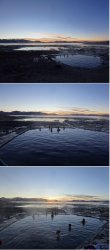

Then back into action, heading ever closer to the Chilean border. Something obviously went bang here a few years ago and lobbed boulders up to the size of Volkswagens all over the place.

Laguna Verde, overlooked by Volcan Licancabur (5960m) which, for anyone who has visited San Pedro de Atacama in Chile would know, also forms a backdrop there. The lake was partly frozen, so its famed green colour was not evident.

Rocas de Dali - Salvador Dali Valley. Up and over some more snow and ice and on and on in big spaces.


Valle de Rocas.

Phwoar - what a blast! Then it was back to Uyuni town after three sensational days to overnight before heading to Potosi.

Accommodation in the National Park is basic but quite serviceable for an overnight stay, especially as we got in just on dark and were up early to be away by 0500h the next day. It’s really just a rather large refugio. Our meal was prepared by our drivers. This is expedition travel.
It was still dark when we got going next morning. The refugio was at a little over 4200m and we were heading to peak just on 5000m at Sol de Manana geysers.

The hot mudpools were a bit too dangerous to get close to in the dark, so a quick look and on into the breaking dawn to the Polques hot springs. Well worth braving a few minutes’ cold to break out the budgie smugglers and plop in for a soak while the drivers prepared breakfast in the refugio. A flying start to another day.



Then back into action, heading ever closer to the Chilean border. Something obviously went bang here a few years ago and lobbed boulders up to the size of Volkswagens all over the place.

Laguna Verde, overlooked by Volcan Licancabur (5960m) which, for anyone who has visited San Pedro de Atacama in Chile would know, also forms a backdrop there. The lake was partly frozen, so its famed green colour was not evident.

Rocas de Dali - Salvador Dali Valley. Up and over some more snow and ice and on and on in big spaces.


Valle de Rocas.

Phwoar - what a blast! Then it was back to Uyuni town after three sensational days to overnight before heading to Potosi.
JohnM
Enthusiast
- Joined
- Jun 7, 2006
- Posts
- 11,812
- Qantas
- LT Gold
Thanks, mate. Still a long way to go with this TR.
Planning is well under way for 2019. So far it's looking like nearly half the year away over several episodes. Kimberley in the Wet in March, maybe a drive east before that, Chile, Argentina, Uruguay in March-April using some QF FF points in J on EK to get there and in J on QR to get back. I'm still waiting for flights to open for the latter part of 2019's DONEx from June-October, which will take in Mexico, Alaska, far NE coast of Russia, the 5 Stans, N India, Sri Lanka - and a few other bits and bobs along the way. Milestone birthday next year - have to pile it on while the going is still good - and I can get insurance...
Mind you, 2018 is not yet done. A couple of weeks in Sudan is coming up in November
juddles
Suspended
- Joined
- Aug 2, 2011
- Posts
- 5,283
- Qantas
- Platinum 1
Hey there John - have been very busy last few weeks in Chile - just getting up to speed with the TR. Internet is hopeless at the moment - it is the 18th Sept national holiday in Chile and so my fishing village is overrun by tourists/internet users)
JohnM
Enthusiast
- Joined
- Jun 7, 2006
- Posts
- 11,812
- Qantas
- LT Gold
Departing Uyuni town; Salar de Uyuni in the background. The journey to Potosi (4100m) was mostly on the undulating uplands. Potosi is the location of the famed Cerro Rico (rich mountain), the source of most of the Spanish Empire’s silver from about 1545. It looms over the town.
It is still being mined in a similar way to the past – many small operators, making the mountain like a rabbit warren of small tunnels, rather than a big company coming in and stripping the whole lot from top to bottom or one side to another. It produces tin, zinc and lead as well as silver.

The centre of Potosi is a very pleasant and tidy example of colonial architecture. It is a World Heritage site.



A Statue of Liberty facsimile in the main square. Top hats are the local variant of the bowler for the cholitas.

It is still being mined in a similar way to the past – many small operators, making the mountain like a rabbit warren of small tunnels, rather than a big company coming in and stripping the whole lot from top to bottom or one side to another. It produces tin, zinc and lead as well as silver.

The centre of Potosi is a very pleasant and tidy example of colonial architecture. It is a World Heritage site.



A Statue of Liberty facsimile in the main square. Top hats are the local variant of the bowler for the cholitas.

JohnM
Enthusiast
- Joined
- Jun 7, 2006
- Posts
- 11,812
- Qantas
- LT Gold
The historic National Mint museum is a major attraction. The mint was built in the mid 1700s, It takes up a whole city block and is very well maintained and curated. Well worth a visit. The bizarre Bacchus mask, hung in 1865 by a Frenchman, has become a town icon, known as the mascaron.

The massive wooden metal-rolling mills and presses – with very lifelike props.

Coin and art galleries.

Mineral gallery. @RooFlyer would have been in raptures.

Some silver objects and the church.

Potosi is very pleasant at night.
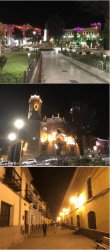

The massive wooden metal-rolling mills and presses – with very lifelike props.

Coin and art galleries.

Mineral gallery. @RooFlyer would have been in raptures.

Some silver objects and the church.

Potosi is very pleasant at night.

JohnM
Enthusiast
- Joined
- Jun 7, 2006
- Posts
- 11,812
- Qantas
- LT Gold
Next day was a visit to one of the mines on Cerro Rico, via the market and one of the processing plants. Pedro, our local born-showman guide who claimed to be a former miner before starting his tour business, needed to stock up on coca leaves and show us how we could buy a stick or two of dynamite, and some detonators and fuses if we wished.
Pedro was definitely born for the guide job – but it was difficult to know where the facts ended and the hyperbole began. Anyway, it was interesting and entertaining.
No shortage of coca leaves. Pedro, with left jowl distending, shows how the stalk of the leaf is discarded after a very quick ingesting motion to strip off the leaf material. Walking through the Dickensian flotation plant.

Up onto Cerro Rico and its honeycomb of small mines. It is quite amazing to think that this has been going on continuously since 1545.

Entering the mine and pausing at the offering shrine to the gods. Pedro’s left jowl stretched further.

It seems that each miner works at least semi-independently, wheelbarrowing ore out and dumping it in his own bay. How they keep track of all of this as it works its way through the processing chain, I do not know.

Next day it was on to Sucre (2750m), the ‘white city’ and the constitutional capital of Bolivia. It’s a World Heritage site.
Sllightly lower altitude, suitable soils and topography, and mild climate means more agriculture – and pervasive eucalypts that are hard to escape in any temperate region around the world – on the way.

I wouldn’t mind having a monoploy on white paint in Sucre.


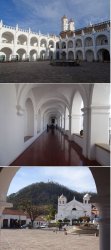
Nice market. Range of avocado varieties and sizes like you’ve never seen. Similarly for spuds.

Pedro was definitely born for the guide job – but it was difficult to know where the facts ended and the hyperbole began. Anyway, it was interesting and entertaining.
No shortage of coca leaves. Pedro, with left jowl distending, shows how the stalk of the leaf is discarded after a very quick ingesting motion to strip off the leaf material. Walking through the Dickensian flotation plant.

Up onto Cerro Rico and its honeycomb of small mines. It is quite amazing to think that this has been going on continuously since 1545.

Entering the mine and pausing at the offering shrine to the gods. Pedro’s left jowl stretched further.

It seems that each miner works at least semi-independently, wheelbarrowing ore out and dumping it in his own bay. How they keep track of all of this as it works its way through the processing chain, I do not know.

Next day it was on to Sucre (2750m), the ‘white city’ and the constitutional capital of Bolivia. It’s a World Heritage site.
Sllightly lower altitude, suitable soils and topography, and mild climate means more agriculture – and pervasive eucalypts that are hard to escape in any temperate region around the world – on the way.

I wouldn’t mind having a monoploy on white paint in Sucre.



Nice market. Range of avocado varieties and sizes like you’ve never seen. Similarly for spuds.

JohnM
Enthusiast
- Joined
- Jun 7, 2006
- Posts
- 11,812
- Qantas
- LT Gold
Parque Cretacico (Cal Orck’o), just outside Sucre has the world’s largest collection of dinosaur footprints. They were discovered in 1994 as part of excavations for the adjacent cement quarry and the (now near vertical) mudstone face containing the many lines of monstrous footprints has been preserved while the quarry operates around it and its dinosaur theme park.

In the afternoon I wandered over to the cemeterio municipal. Like the cemetery in La Paz that I travelled over on the Teleferico, it is all above ground with mausoleum buildings looking like miniature blocks of flats.

Next day it was the short hop back to Lima for a few days (already reported on live upthread), before resuming the DONE5 LIM-GRU, followed the next day by a GOL whY flight GRU-CGB (Cuiaba) to kick off the Pantanal tour.

In the afternoon I wandered over to the cemeterio municipal. Like the cemetery in La Paz that I travelled over on the Teleferico, it is all above ground with mausoleum buildings looking like miniature blocks of flats.

Next day it was the short hop back to Lima for a few days (already reported on live upthread), before resuming the DONE5 LIM-GRU, followed the next day by a GOL whY flight GRU-CGB (Cuiaba) to kick off the Pantanal tour.
JohnM
Enthusiast
- Joined
- Jun 7, 2006
- Posts
- 11,812
- Qantas
- LT Gold
The word pantano means ‘swamp’ in both Spanish and Portuguese, but the Pantanal is really a vast, very flat alluvial plain. It is the world’s largest tropical wetland at around 150,000-200,000 sq km and supports a great diversity of life – which is much easier to spot than in the dense jungles of places like the Amazon basin. Most of it is in Brazil, but it extends into Bolivia and Paraguay. Much of the area in Brazil was once part of Bolivia but, in yet another war the Bolivians lost, it was ceded to Brazil.
It is surrounded by higher ground and during the wet season the water flowing down the Paraguay and other rivers overflows their banks and spreads gently across the plain. Animals gradually cluster on the resulting vegetation islands (cordilheiras). In a similar but reverse process as the waters recede, animals retreat to and concentrate in the shrinking ponds and along the river floodplains.
The seasonal process limited agriculture on large parts of the plain to patchy cattle grazing and has kept much of the habitat suitable for the natural wildlife. Many eco-tourism lodges have sprung up from now less economical grazing farms along the Transpantaneria, a raised dirt road that extends deep into the Pantanal.
The sole purpose of the trip into the Pantanal was to observe wildlife in two parts of the region. Firstly, along the Paraguay River and its extensive network of adjacent flood plain channels. The key target there was to spot jaguars (Panthera onca - Jaguar - Wikipedia). Jaguars look like leopards but are stockier and, like tigers, they swim. Secondly, to experience the array of wildlife and the habitat at an eco-lodge-cough-farm on the true Pantanal plain as the landscape was trending towards the dry season, allowing good accessibility and the wildlife was concentrating into the remaining pools.
After grouping and a night at Cuiaba, the capital of Matto Grosso, four nights was spent at Baiazinha Lodge on the banks of the Paraguay River, with twice-daily boat excursions down the river and into channels to maximise the chances of spotting a jaguar. The following three nights were spent at Araras Lodge which sits beside the Transpantaneira.
The target region relative to Bolivia – with the Salar de Uyuni clearly visible. Great landscape contrast!


On the drive into the river lodge and the lodge – Hyacinth Macaw. I covered some of around the river and lodge earlier with live posts of pics from my phone.

Red-crested Cardinal. Capybaras. I’m working my way through my pics in day-by-day sequence. Apologies for any repetition if I come across better pics but have already posted or omit to edit accordingly.
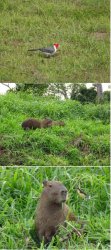
Snail Kite. Jabiru Storks (and an idea of the habitat – including plenty of water hyacinth which is native to S America but is a massively invasive weed in some other parts of the world). Green Iguana. (I’ll name as many species as my simple cheat-sheet will reliably allow…)

Caimans galore. Southern Screamer (I think). Many herons.
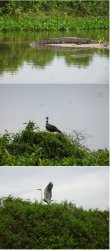
Ringed Kingfisher. Grey-necked Wood-Rail. Tiger Heron.

Pretty reflections as the sun peeked through. Orange-backed Troupial.

Black-collared Hawk. ?. End of day 1 and no jaguar. Six opportunities to go…

It is surrounded by higher ground and during the wet season the water flowing down the Paraguay and other rivers overflows their banks and spreads gently across the plain. Animals gradually cluster on the resulting vegetation islands (cordilheiras). In a similar but reverse process as the waters recede, animals retreat to and concentrate in the shrinking ponds and along the river floodplains.
The seasonal process limited agriculture on large parts of the plain to patchy cattle grazing and has kept much of the habitat suitable for the natural wildlife. Many eco-tourism lodges have sprung up from now less economical grazing farms along the Transpantaneria, a raised dirt road that extends deep into the Pantanal.
The sole purpose of the trip into the Pantanal was to observe wildlife in two parts of the region. Firstly, along the Paraguay River and its extensive network of adjacent flood plain channels. The key target there was to spot jaguars (Panthera onca - Jaguar - Wikipedia). Jaguars look like leopards but are stockier and, like tigers, they swim. Secondly, to experience the array of wildlife and the habitat at an eco-lodge-cough-farm on the true Pantanal plain as the landscape was trending towards the dry season, allowing good accessibility and the wildlife was concentrating into the remaining pools.
After grouping and a night at Cuiaba, the capital of Matto Grosso, four nights was spent at Baiazinha Lodge on the banks of the Paraguay River, with twice-daily boat excursions down the river and into channels to maximise the chances of spotting a jaguar. The following three nights were spent at Araras Lodge which sits beside the Transpantaneira.
The target region relative to Bolivia – with the Salar de Uyuni clearly visible. Great landscape contrast!


On the drive into the river lodge and the lodge – Hyacinth Macaw. I covered some of around the river and lodge earlier with live posts of pics from my phone.

Red-crested Cardinal. Capybaras. I’m working my way through my pics in day-by-day sequence. Apologies for any repetition if I come across better pics but have already posted or omit to edit accordingly.

Snail Kite. Jabiru Storks (and an idea of the habitat – including plenty of water hyacinth which is native to S America but is a massively invasive weed in some other parts of the world). Green Iguana. (I’ll name as many species as my simple cheat-sheet will reliably allow…)

Caimans galore. Southern Screamer (I think). Many herons.

Ringed Kingfisher. Grey-necked Wood-Rail. Tiger Heron.

Pretty reflections as the sun peeked through. Orange-backed Troupial.

Black-collared Hawk. ?. End of day 1 and no jaguar. Six opportunities to go…

JohnM
Enthusiast
- Joined
- Jun 7, 2006
- Posts
- 11,812
- Qantas
- LT Gold
An extraordinary array of birdlife. Mostly storks and Roseate Spoonbills in this concentration.

Giant Otter.

We had all been concentrating on this up high, when I turned around and spotted something lower. Bingo!

It then got up and walked along the river before turning into the vegetation. That afternoon we came across what the guides were sure was the same animal lolling about under a tree some distance away. Excursions 2 & 3 out of 7 had hit the jackpot. That was not to be repeated until the final excursion.


So, jumping ahead to the last excursion when we encountered in the one afternoon three different jaguars! The last one was a great sighting on a sandbank, but the sun was right behind and getting low, so getting pics was impossible. When it got up and walked away, it was in a slight dip in the ground on the other side of the sandbank. Anyway, mission accomplished!


Giant Otter.

We had all been concentrating on this up high, when I turned around and spotted something lower. Bingo!

It then got up and walked along the river before turning into the vegetation. That afternoon we came across what the guides were sure was the same animal lolling about under a tree some distance away. Excursions 2 & 3 out of 7 had hit the jackpot. That was not to be repeated until the final excursion.


So, jumping ahead to the last excursion when we encountered in the one afternoon three different jaguars! The last one was a great sighting on a sandbank, but the sun was right behind and getting low, so getting pics was impossible. When it got up and walked away, it was in a slight dip in the ground on the other side of the sandbank. Anyway, mission accomplished!

JohnM
Enthusiast
- Joined
- Jun 7, 2006
- Posts
- 11,812
- Qantas
- LT Gold
Some random shots.


Stork in nest. Guira Cuckoo. Bare-faced Curassow.

Southern Caracara. Roadside Hawk. Black-collared Hawk (I think).

Maybe a Black-crowned Night-heron. ? heron. Great Black Hawk with crab prey.

Laughing Falcon. Wattled Jacana. Tranquillo scene.

Caiman with very large fish prey. But notice another caiman sneaking in from the left… Then splash!

Capped Heron. Giant Otter on land. Toco Toucan.

And that was it for the Paraguay River part of the trip.


Stork in nest. Guira Cuckoo. Bare-faced Curassow.

Southern Caracara. Roadside Hawk. Black-collared Hawk (I think).

Maybe a Black-crowned Night-heron. ? heron. Great Black Hawk with crab prey.

Laughing Falcon. Wattled Jacana. Tranquillo scene.

Caiman with very large fish prey. But notice another caiman sneaking in from the left… Then splash!

Capped Heron. Giant Otter on land. Toco Toucan.

And that was it for the Paraguay River part of the trip.
JohnM
Enthusiast
- Joined
- Jun 7, 2006
- Posts
- 11,812
- Qantas
- LT Gold
- Status
- Not open for further replies.
Become an AFF member!
Join Australian Frequent Flyer (AFF) for free and unlock insider tips, exclusive deals, and global meetups with 65,000+ frequent flyers.AFF members can also access our Frequent Flyer Training courses, and upgrade to Fast-track your way to expert traveller status and unlock even more exclusive discounts!

AFF forum abbreviations
Wondering about Y, J or any of the other abbreviations used on our forum?Check out our guide to common AFF acronyms & abbreviations.
Currently Active Users
- FishFood
- JoshuaL1997
- Ikara
- Want2flymore
- Harrison_133
- CBR001
- FlyingFiona
- Askance
- ixit
- justinbrett
- jason_c
- arrow
- Scr77
- MVM
- eric2011
- kpc
- sudoer
- furiousmango
- Mrsfefe
- pauly7
- cjd600
- flyingfan
- Stay No Stay
- HirafuHeartAttack
- SydneySwan
- Denali
- FwWine
- mjt57
- cambriamarsh
- Viridis
- mviy
- TonyDoh
- bussyboy
- Beachy55
- http_x92
- kearvaigskewer
- 1erCru
- hydrabyss
- Saab34
- CMA222
- watzy
- flyerboy
- onemorejohndoe007
- MB123
Total: 807 (members: 51, guests: 756)















